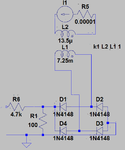schmitt trigger
Advanced Member level 5
At 20uS the secondary can sustain 149/20 = 7.45 volts.
But you need to subtract two diode drops from that.
Your required two volts will be well below that limit.
But Tony, for improved linearity,
isn't it a good design practice to operate any "sensing" transformer well below its maximum spec?


